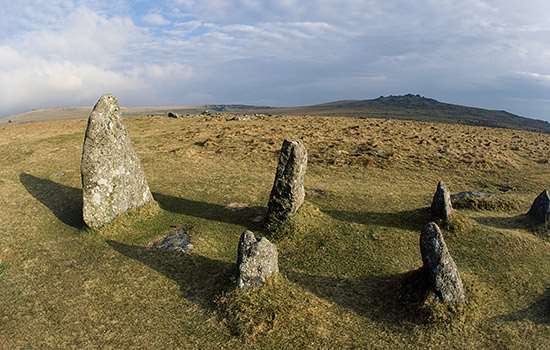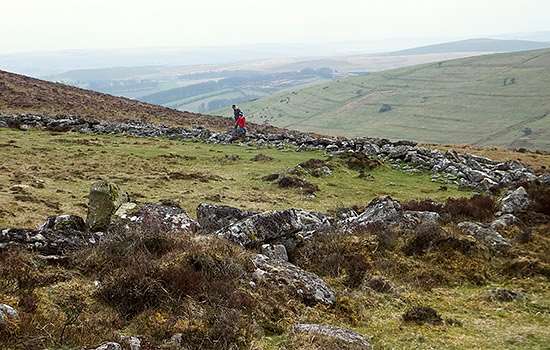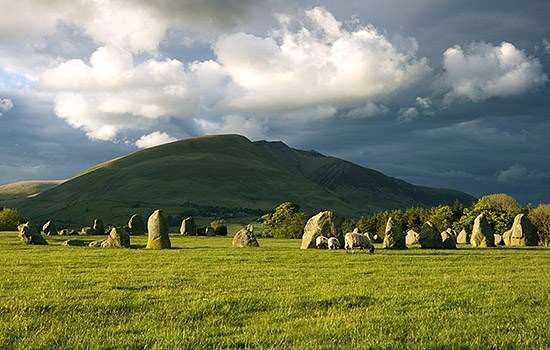Stone Rows and Circle
The most prominent features of Merrivale are the two double stone rows running east to west. Each consists of more than 150 stones, mostly under a metre high.
The northern double row is 182 metres long, with an average width between the rows of 1 metre. The second row runs roughly parallel with the first but is longer, stretching 263 metres across the moor. It has terminal stones blocking each end. Near the middle of this row, a ring of stones marks the kerb of a small cairn. This unusual feature may mark the burial of an important person. We don’t know whether it is earlier or later in date than the stone rows.
A few metres south is a stone-lined burial chamber, or cist, with a massive, though damaged, capstone. Further west and just to the south of the row, a cairn marks the start of a single row of stones, running for about 40 metres at an angle to the double row.
To the west of these rows is a circle of 11 low-lying stones of local granite, about 18 metres in diameter. There is a tall stone, or menhir, nearby, which at more than 3 metres high is the most conspicuous monument in the area.
A ritual landscape
It is quite possible that the ritual monuments of the Merrivale landscape belong to several different periods. In what way they might be related is a matter of conjecture, but such a vast array of monuments indicates that the site was of great spiritual importance to the people who lived in the area.
Whatever ceremonies were held here, the amount of planning, motivation and organisation that went into creating such a complex of sites is astonishing. Stone rows have been described as the most distinctive monuments of prehistoric Dartmoor. There are at least 70 examples, often built in conjunction with cairns as at Merrivale.
Bronze Age settlement
There are remains of over 50 roundhouses spread across the hillside north of the stone rows. These represent a Bronze Age settlement, where people were living and farming about 3,000 years ago. The people living here were probably mainly keeping sheep and cattle. The houses vary in size, but some of the larger ones are about 8 metres across: these were substantial structures, each supporting a massive thatched roof.
We don’t know why this much later settlement was sited beside the much earlier ritual monuments. However, it is likely that the stone rows and circle would have held significance for the community here as well as their Neolithic predecessors.
Running west of the site is the Great Western Reave, the longest of the many reaves – earth or stone banks, probably representing ancient field boundaries – that are a distinctive feature of Dartmoor. Many of them stretch for miles across the moor. Such reaves, and the field systems sometimes associated with them, show the considerable impact that Bronze Age farmers had on the Dartmoor landscape.
Merrivale’s inhabitants probably abandoned it towards the end of the Bronze Age. By 800 or 700 BC, the fragile granite soil of upland areas like this would have become so degraded as a result of extensive farming and deforestation that it had become moorland, making further cultivation impossible.
The huge round stone here, often mistaken for a prehistoric feature, is in fact a post-medieval apple-crusher stone, used during cider-making.
Image gallery
Further reading
Butler, J, Dartmoor Atlas of Antiquities (5 vols, Tiverton, 1991–7)
Gerrard, S, Dartmoor (English Heritage, London, 1997)
Greeves, T, The Archaeology of Dartmoor from the Air (Exeter, 1985)
Griffith, F, Devon’s Past: An Aerial View (Exeter, 1988)
Griffiths, D, A Guide to the Archaeology of Dartmoor (Bovey Tracey, 1996)
Newman, P, The Field Archaeology of Dartmoor, revised edn (Swindon, 2016)
Sale, R, Dartmoor: The Official National Park Guide (Newton Abbot, 2000)
Find out more
-

Visit Merrivale Prehistoric Settlement
The group of monuments at Merrivale is one of the finest on Dartmoor: side by side here are the remains of a Bronze Age settlement and a complex of ritual sites.
-

Listen to our audio guide
Our audio guide is designed to be enjoyed whether you are visiting Merrivale or just want to listen at home.
-

Dartmoor’s Historic Landscape
Find out more about all the sites that English Heritage looks after on Dartmoor, one of England’s greatest archaeological landscapes.
-

PREHISTORIC MONUMENTS
England’s prehistoric monuments span almost four millennia. Discover what they were used for, how and when they were built, and where to find them.
















